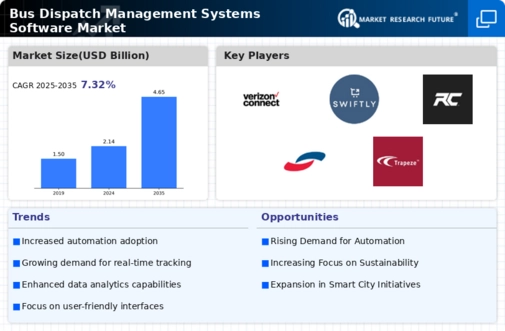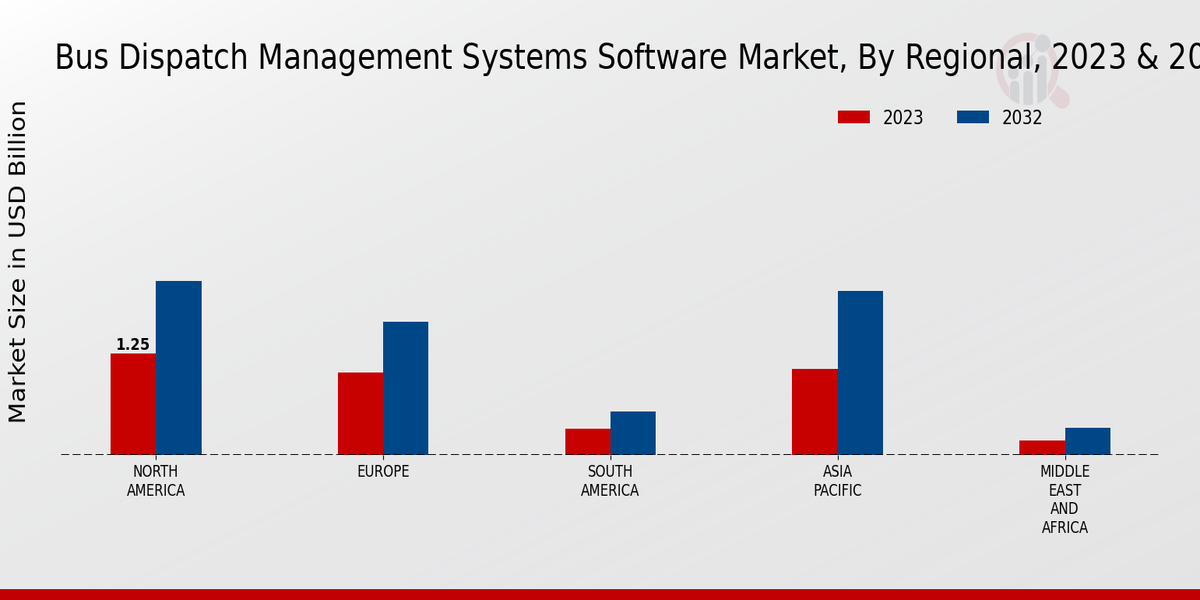Market Growth Projections
Market growth projections for the Global Bus Dispatch Management Systems Software Market Industry indicate a robust upward trajectory. The market is anticipated to reach 2.14 USD Billion in 2024, with expectations of expanding to 4.65 USD Billion by 2035. This growth reflects a compound annual growth rate of 7.3% from 2025 to 2035, suggesting a strong demand for innovative dispatch solutions. The increasing complexity of urban transportation systems and the need for efficient fleet management are likely to drive this expansion. As transit authorities adopt advanced technologies, the market is poised for significant growth in the coming years.
Government Initiatives and Funding
Government initiatives and funding play a pivotal role in shaping the Global Bus Dispatch Management Systems Software Market Industry. Many governments worldwide are investing in public transportation infrastructure to promote sustainable urban mobility. These investments often include grants and subsidies for adopting advanced dispatch management systems. For instance, various countries are implementing policies aimed at reducing carbon emissions, which indirectly boosts the demand for efficient bus dispatch solutions. The projected compound annual growth rate of 7.3% from 2025 to 2035 indicates that government support will likely continue to drive market growth, fostering innovation and enhancing service quality.
Rising Urban Population and Commuter Needs
The Global Bus Dispatch Management Systems Software Market Industry is significantly impacted by the rising urban population and evolving commuter needs. As urban areas expand, the number of commuters increases, necessitating more efficient public transport solutions. Bus dispatch management systems help transit authorities respond to these changing dynamics by providing tools for better route planning and passenger information systems. The increasing complexity of urban transport networks requires sophisticated software solutions to ensure timely and reliable service. This trend is expected to contribute to the market's growth, as agencies seek to enhance their operational capabilities to meet the demands of a growing urban populace.
Technological Advancements in Fleet Management
Technological advancements significantly influence the Global Bus Dispatch Management Systems Software Market Industry. Innovations such as GPS tracking, automated scheduling, and data analytics enhance fleet management capabilities. These technologies allow for real-time monitoring of bus locations, enabling transit operators to make informed decisions regarding route adjustments and maintenance needs. As a result, operational efficiency improves, leading to cost savings and better service delivery. The anticipated growth of the market to 4.65 USD Billion by 2035 underscores the importance of adopting advanced technologies in fleet management, as they are likely to drive competitive advantages for transit agencies.
Focus on Sustainability and Environmental Concerns
The Global Bus Dispatch Management Systems Software Market Industry is increasingly influenced by a focus on sustainability and environmental concerns. As cities strive to reduce their carbon footprints, there is a growing emphasis on optimizing public transport systems. Bus dispatch management software aids in minimizing fuel consumption and emissions by facilitating efficient routing and scheduling. This aligns with global sustainability goals and enhances the appeal of public transport. The market's growth trajectory suggests that as environmental awareness rises, the demand for software solutions that support sustainable practices will likely increase, further propelling market expansion.
Increasing Demand for Efficient Public Transport Solutions
The Global Bus Dispatch Management Systems Software Market Industry experiences a rising demand for efficient public transport solutions. Urbanization and population growth necessitate improved transit systems to manage increased passenger volumes. As cities expand, the need for effective scheduling, routing, and real-time tracking becomes paramount. This software enables transit authorities to optimize operations, reduce delays, and enhance service reliability. In 2024, the market is projected to reach 2.14 USD Billion, reflecting the urgency for innovative solutions in public transportation. The integration of technology in bus dispatching is likely to play a crucial role in meeting these demands.







